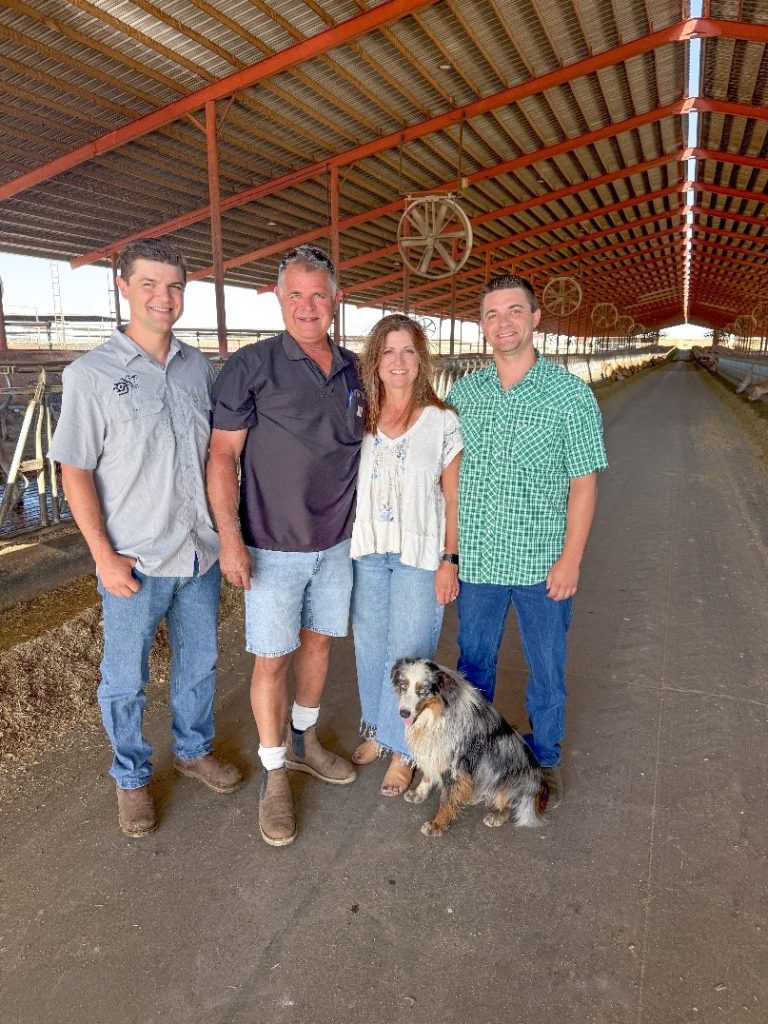
The Fernandes family has been dairying in California’s San Joaquin Valley since the 1920s, when Frank Fernandes came over from the Azores and started milking cows during the Great Depression. A century later, his grandsons continue to dairy and have expanded on multiple facilities— and now, they’re also producing renewable fuel from manure while capturing methane that would be emitted as a powerful greenhouse gas to the atmosphere.
Joe Fernandes passed the operation to his six sons: Joey, Greg, Gary, Frank, Jared, and Josh. Together, they manage four Tulare County dairies with anaerobic digesters funded by CDFA Dairy Digester Research and Development Program (DDRDP) —Fern Oaks (2019), Legacy Ranch (2017), LegenDairy Farms (2022), and Sousa & Sousa (2018, also known as Legacy Holsteins). All four dairies are based in Tulare County as a part of the Calgren Dairy Fuels Cluster, California’s first full-scale dairy pipeline network. In total, the four projects received $5.3 million through DDRDP. Greg runs Fern Oaks; Gary runs LegenDairy; Jared and Josh manage daily operations at Legacy Ranche, while Frank handles farming. Most digesters were built with Maas Energy Works. Joey also developed a separate project through a DDRDP grant with California Bioenergy.

The DDRDP grants helped Maas Energy Works, Calgren, and their partners deploy covered lagoon digester technology across multiple dairies, expanding California’s largest dairy biogas pipeline cluster, supporting the state’s investment in renewable energy infrastructure and meeting the state’s ambitious climate goals by significantly decreasing methane emissions from manure.
By offsetting upfront infrastructure costs and reducing risk for dairy owners, the funding made the project financially feasible. It also accelerated the adoption of low-emission technology and increased the supply of low-carbon, renewable transportation fuels.
How the Calgren Digesters Work
Each digester captures methane from manure, which is then sent to the Calgren facility where it is processed and upgraded into renewable natural gas (RNG). The RNG is either compressed onsite or piped into the utility grid. That RNG powers trucks and helps replace diesel with low-carbon fuel. Every upgrade serves a clear purpose: to run a cleaner, smarter, and more resilient farm.

Calgren employs an experienced team of operators and mechanics who visit the digester sites multiple times per week to conduct routine inspections and maintenance. This includes checking equipment functionality, inspecting the digester covers, and ensuring steady manure flow into and out of the system. Around the clock, Calgren’s operations team also monitors the entire digester network from a centralized control room, ensuring that biogas is continuously processed and reliably injected into the SoCalGas pipeline. Together, the family’s digesters are estimated to be reduced by over 550,000 metric tons of greenhouse gas (GHG) emissions over the next 10 years.
Farm Practices That Make a Difference
The Fernandes dairies focus on practical upgrades that improve animal welfare, cut GHG emissions, and keep the farm running efficiently. Depending on the site, those upgrades include:
- Sand bedding for cow comfort and reuse
- Sand bedding improves cow comfort and hoof health. It’s also recycled, reducing costs and waste. (Used at all dairies except Sousa & Sousa)
- Bagged silage to reduce feed losses
- All dairies use bagged silage instead of stacking it in piles. This reduces spoilage and shrinkage from ~15% to ~2%, preserving more of the harvested feed and improving overall efficiency.
- On-farm solar
- Legacy Ranch 2, Fern Oaks, and LegenDairy have solar panel installations that provide renewable power, lowering utility bills and GHG emissions.
- LED lighting upgrades
- Legacy Ranch and LegenDairy use LED lighting throughout their dairies—an energy-efficient alternative to traditional lighting that reduces electricity use.
- Cow Manager health monitoring system
- LegenDairy uses Cow Manager®, a system of ear tags that tracks cow activity, eating behavior, rumination, and temperature to detect illness early and ensure timely treatment and management.
- Healthy Soils Program participation
- Legacy Ranch 2 received funding from CDFA’s Healthy Soils Program to adopt conservation tillage, a practice that reduces soil disturbance, helping retain carbon and lower emissions.
As Gary Fernandes puts it, their approach comes down to lessons passed down from their dad, Joe:
“You take care of the cows, they take care of you.”
“Control the things you can control.” — Joe Fernandes
These values continue to shape how the family runs their dairies—one decision at a time.
What Other Dairies Can Learn
The Fernandes family didn’t do this alone. They partnered with Calgren Dairy Fuels, Maas Energy Works – and California’s incentive program, DDRDP – to share infrastructure and get technical support with digester operations. That teamwork helped lower costs and keep the projects sustainable long-term.
Their success shows that family dairies can:
- Cut costs by sharing pipeline infrastructure
- Protect the land and keep the business strong
- Use California’s climate programs to fund real projects
California Climate Investments and GHG Reductions
The Fernandes family’s digesters represent a major step forward in climate-smart agriculture. Each was supported in part by grant funding from California’s Dairy Digester Research and Development Program (DDRDP), administered by CDFA and funded through California Climate Investments (CCI).
In total, the projects received over $5.3 million in state grants—reducing greenhouse gases, improving local air quality, and supporting Tulare County’s agricultural economy.
“AMMP and DDRDP are part of California Climate Investments, a statewide initiative that invests billions from Cap-and-Trade dollars into reducing greenhouse gas emissions, boosting the economy, and enhancing public health and the environment—especially in disadvantaged communities.”

